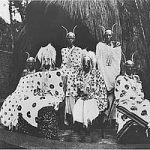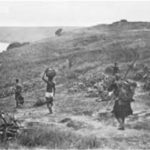Labor Demands
The growth of plantations and other enterprises in Kinyaga led to a progressive augmentation in the wage labor force. Labor demands from Europeans in Kinyaga had to compete with demands from European establishments west of the lake. The development of an urban center at Bukavu (opposite Cyangugu in the Congo) from the late 1920s and higher wages paid in Bukavu and Kivu further exacerbated the labor drain on Kinyaga.
No precise figures are available for the number of Kinyagans employed as wage earners in their own region. Colonial government statistics are available for some years, but not from the same sources for each year. Categories of workers included in the figures for one year sometimes do not appear for other years, making it difficult to compare figures. The colonial government depended on employers to supply statistics on numbers of employees, and upon occasion certain employers did not submit this information.
Similarly, few reliable figures are available on the numbers of Kinyagans who went to work in the Congo, but data from oral accounts and comments in administrative reports indicate that large numbers of Kinyagans went west to work on the plantations of Kivu and in the mines of Kivu and Katanga (now Shaba) in the Congo. Recruitment in Ruanda-Urundi by the Union Minière du Haut Katanga mining company began in 1925 and continued until 1929. During the five-year
period, UMHK sent more than 7000 workers from Ruanda-Urundi to mines in Katanga (Zaïre); there is evidence that a large proportion of the recruits came from Rwanda. No statistics are available as to the number of Kinyagans recruited, but the zone of recruitment did include Cyangugu Territory (excluding the Rusizi Valley.
From 1930, Bukavu grew in importance as a center of services and supply for settlers in Kivu and Kinyaga, adding to demands for labor.” Workmen were needed to build and maintain Bukavu’s buildings; skilled and semi-skilled workers in trades such as mechanics, masonry, and carpentry were in great demand for the service industries of the town. Jobs as domestic servants were abundant, and in later years demand grew for clerks in various businesses. Even though the area around Bukavu was heavily populated, the large number of European plantations in the vicinity added to heavy labor demands there, and workers from other areas (such as Kinyaga) were called on to supplement the local labor supply.
Government reports from the 1930s and later invariably notes the significant impact on Kinyaga of the economic changes and labor demands in Kivu. In 1938, an official report noted that the region is . . . in the zone of attraction of the Congolese district of Kivu, to which it already supplies considerable labor and a variety of products.
The report for 1939-1944 commented in a similar vein:
Kivu… has continued to exert strong economic attraction on this Territory. This has resulted in the ongoing transformation of the activities of the natives of the western region of Shangugu, many of whom prefer to devote themselves to petty commerce or to offer their services to large companies.
Despite their heavy involvement in commerce and wage labor, Kinyagans were still expected to maintain compulsory cultivation of crops and to perform varions types of akazi. In 1946 the Territorial Administrator at Cyangugu assembled the chiefs and subchiefs of the region to give them the following instructions:
1° we appeal to the spirit of collaboration [of the chiefs and subchiefs] to “work better, work more.”
2° We inform the subchiefs who are present of the results of yesterday’s meeting with the settlers and the chiefs. We expect more firm collaboration from the subchiefs so that the indisci
pline so evident among the Bahutu will cease. It is necessary that the native authorities become aware of the fact that they represent the State, and they must rule those they administer with justice and firmness. And in this regard, they must require from all Bahutu [who are] not working for Europeans the completion of all duties with regard to [obligatory] crops, the struggle against erosion, and the maintenance of the roads.
3° The collection of taxes must be intensified.
In 1947 the colonial government’s annual report noted that:
The administration of the chiefdoms of this Territory is rendered more difficult by the proximity of Costermansville [Bukavu] and the arrival of European settlers at Shangugu which gives rise to substantial demands for local labor. Thirty percent of able-bodied men are working for European enterprises.
Again, in 1952:
As in the past, the Territory of Shangugu continues to maintain very close relations with Kivu Province. Each morning hundreds of workers from Shangugu cross the bridge over the Ruzizi to go to work in Costermansville [Bukavu] and return to their homes in the evening.
Official estimates of the number of “seasonal emigrants” from Cyangugu Territory working in Zaïre were 2000 in 1948, 3000 in 1953, 2500 in 1954 and 1955, 2900 in 1958. The official figures for the total number of Kinyagans working in Zaïre in 1952 (including both “permanent” -on contract-and “non-permanent”-employed on a daily basis) was 4178. In 1958 it was estimated that more than 2000 Kinyagans crossed daily from Cyangugu to work in Bukavu alone.
Although these figures provide some indication of the extent of labor demands, they are probably underestimates. In spite of attempts to control and register labor recruitment and labor migration, colonial officials could not have known of all those who went away to work. The efforts of administrators in this regard were complicated by the common practice among Rwandans of using a new name when they undertook contract work.
Comparison of statistics on wage carriers with figures on population is likely to be misleading. Population mobility was high in Kinyaga during the colonial period, and therefore the figures on “hommes adultes valides” (able-bodied men registered in the administration records) were probably overestimates. This possibility is given credence by the situation in Cyesha chiefdom during 1942, at the height of war-time impositions. In a report deploring the harsh exactions being levied on the population, missionaries at the Catholic Mission of Nyamasheke noted that although official figures put the number of taxpayers (able-bodied men) at about 6000, the number actually present in the chiefdom during 1942 was only 3050. In that year, a total of 1520 men were employed on a daily (non-contract) basis. This figure, which did not even include those employed on contract, constituted nearly 50 percent of the actual adult population of the chiefdom at the time (3o5o), although according to official population figures, it would have amounted to only about 25 percent.
Moreover, even if the population figures could be taken as accurate, comparison of statistics on workers with population figures for all of Cyangugu Territory need be regarded with circumspection. Participation in wage labor was much higher in the western parts of the Territory, near the lakeshore and on the hills bordering the Rusizi Rivers. Therefore, a figure showing the number of adult men employed as a percentage of the total number of “hommes adultes valides” in Cyangugu Territory would underrepresent the actual proportion of workers recruited on many particular hills.
The Belgian Administration and Labem Reeruitment
Itwas an integral part of Belgian colonial policy to aid in-if not to organize outright-the recruitment and control of labor. “European enterprise” was regarded as desirable, if not essential, to the functioning of the colony, and members of the administration were expected to facilitate the smooth operation of the settlers’s activities. The administration stipulated regulations for employment of labor, including the terms of labor contracts, and administrators took an active role in recruiting. Indicative of Belgian policy in this regard was a letter sent in 1940 by the Resident of Rwanda to the Territorial Administrator at Cyangugu concerning the months when temporary workers would be particularly welcomed by the coffee planters of Kivu. The communication gave the following instructions:
Please take note of the above [instructions] and do what is necessary so that no obstacle be placed in the way of the hiring of natives under your jurisdiction, especially during the above-mentioned periods.
The instruction that “no obstacle be placed in the way of recruiting workers” carried implications that the Territorial Administrator well understood: the population was to be informed of the “opportunities” to work for wages, and measures designed to encourage or pressure people to work for Europeans (such as higher taxes) were to be vigorously enforced. When the hiring of workers on contract was involved, the local officials were to ensure that various incentives favoring contract workers were in fact applied, such as exempting them from akazi and allowing (in fact obliging) them to make payment in lieu of ubureetwa service. A letter of 1938 from the Territorial Administrator in Cyangugu to three subchiefs regarding labor for the Nyungwe mines reflects these concerns:
I am sending you herewith a copy of an extract from the note dated 30 March 1938 from Monsieur Le Resident du Ruanda, following a labor shortage at the Nyongwe (mine), where the situation, (which is) extremely irksome for the smooth operation [of the mine], should command your full attention:
1) The workers [“engagés”) at Nyongwe have the moral and legal obligation to complete their contract without interruption, even if they have not signed a regular- contract, for they have all received equipment.
2) The chiefs and subchiefs have absolutely no right to recall to their hills any natives who have signed on to work for this enterprise.
3) The chiefs and subchiefs do not have the right to require that the wives and children of the workers carry out [obfigatory] cultivation as provided for by Regulation 89.
4) The chiefs and subchiefs have no right to require the workers at Nyongwe to perform forced labor associated with ubureetwa; it is sufficient to remind them that the mine workers living in the workers’ camps pay their ikoro, ibihunikwa and ubureetwa taxes in money and that the obligatory work duties thus paid for will be paid in money to the rightful claimants.
5) The chiefs and subchiefs are obliged to retum immediately to the mine all those from their administrative domain who have left work without having successfully completed their contract.
European settlers in Kivu would sometimes write to Kigali requesting permission from the Resident of Ruanda to recruit workers in Cyangugu; the Resident would then send instructions to the Territorial Administrator at Cyangugu to provide assistance in labor recruitment.
European administrative authorities in Bukavu and Kivu province also used Cyangugu Territory as a labor pool. Several requests for workers addressed to the Territorial Administrator in Cyangugu during 1947 illustrate this point. In May 1947 the Territorial Administrator at Bukavu requested that Cyangugu send 20 workers to help prepare administrative buildings of the town for a visit by the Prince Regent and the Minister of Colonies from Belgium. In November of the same year, Cyangugu was called on to supply workers for preparation of the Bukavu racetrack before a horse race, and in December the Governor of Kivu Province wrote to the Territorial Adrninistrator at Cyangugu requesting a force of 120 workers to be “used for upkeep of the gardens of Costermansville and paid at the normal rate.” An order was then sent from Cyangugu to Biniga, the Chief of Abiiru Province, instructing him to send twenty of the workers, which the Governor of Kivu wished to have immediately:
To meet a request from the Governor [of Kivu], it is your responsibility to supply as soon as possible 20 workers to the [government] Agricultural Officer . . . in Costermansville.
As the labor force grew in size, the attempts to control contract labor required increasing attention on the part of colonial officials in Cyangugu. Regulations governing contracts imposed sanctions for any worker who “deserted” before the expiration of his contract; the government was to pursue and retum to the employer any Rwandan known to have broken a work contract. Employers (in Kivu, Kinyaga, and elsewhere) filed complaints with the Territorial Administrator at Cyangugu about residents of Cyangugu Territory who had left before terminating their contracts, and the volume of such complaints came to dominate the work of the Territorial Administration at Cyangugu during the 1950s.
Chiefs and Labor Recruitment
Chiefswere expected to play an active role in labor recruitment. A 1929 report noted that the administration encountered no difficulty recruiting workers; the A.T. would establish a list for each of the hills adjoining an area where work was in progress on construction or road-building, and the chiefs of the area would be instructed to deliver a specified number of workers. Until about I930 it was common practice throughout Rwanda for chiefs who recruited workers to take the wages for themselves.Several Kinyagans confirmed this; one claimed
that during the 1920s a delegate of Rwagataraka had recruited him to work on a European enterprise at Kamembe. About 150 men worked there, making cigars and operating Machines to produce sacks. The wages were taken by the recruiter; the workers received nothing. By collaborating in recruiting workers for European settlers, chiefs also gained additional discretion over the population; it was left to the chiefs and subchiefs to decide who had to go and who would be allowed to stay.
Although European administrators were aware of such problems, the abilities of Rwandan authorities to circumvent any controls were generally more effective than the controls themselves. In fact, the system worked also to the benefit of the European community, including the administrators themselves. Consequently, the colonizer was caught in the contradictory position of attempting to assure “adequate” administrative authority in the hands of the Tuutsi chiefs on the one hand, and professing the desire to control abuses on the other. The administrative system was predicated on the basis of chiefiy power; only individual administrators were concerned about abuses.
But in sending people to work for Europeans the chiefs were undermining their own authority over the long term. Working as wage eaners gave some Kinyagans a chance to gain economic independence and, eventually, a certain autonomy vis-à-vis the chiefs. A growing awareness of this and an unwillingness to relinquish rural manpower from local projects (including the cultivation of chiefs’fields) may help to account for the reluctance of chiefs to cooperate with labor recruitment efforts during the 1930s. As demands for labor increased, some chiefs tried to hinder recruitment in their areas by making life extremely uncomfortable for people who went to work for Europeans; this occurred even in the face of increasing demands on government adrministrators to provide greater numbers of workers. A circular issued by the Resident of Ruanda in 1934 indicates some of the means used by the chiefs to discourage workers:
It has come to my attention that in various territories the native authorities sometimes impede the hiring of people under their jurisdiction for work in European establishments.
This obstruction takes a great variety of forms: sometimes a sub-chief evicts a native from his hill because the latter has been hired for a long term [contract] by a neighboring enterprise; sometimes another [subchief ] opposes engagements [for wage labor] because his people have [already] paid the [head] tax; in other cases the customary authorities claim the right to deny authorization for wage employment to natives who have not fulfilled their required labor obligations or who have not completed the work imposed by the Administration.
This obstruction must cease and every muhutu must remain free to sign a contract whenever he wishes with an enterprise within the country or in the Belgian Congo.
Although the circular was intended as a general statement applying to all of Rwanda, specific incidents in Cyangugu suggest its particular relevance to conditions of that region. In 1937, a Kinyagan who had signed a contract with Symétain at Kalima (Zaïre) lodged a complaint that a cow he had left behind with a friend had been confiscated by the chief Rwagataraka. In 1947, the employer of a Kinyagan from Abiiru Province sent a complaint to the Territorial Administrator at Cyangugu charging that his employee’s wife had been beaten by the local sub-chief ‘s representative in order to force her to carry out a corvée!’ Kinyagans consulted during the research referred frequently to the “abuses of the chiefs” who would often force the wives of men who were away working to carry out ubureetwa services, and administrative documents confirm that such practices were a constant source of complaints.
A subchief who did not produce labor for Europeans, falied to produce work gangs for akazi, or did not succeed in making people carry out the obligatory cultivation of manioc, coffee, and so on was liable to lose his position. But the chiefs imposed exactions on their people far exceeding that was “legally” permitted by colonial regulations. This could be traced in part to the difficulties of reconciling the capabilities of the system with contradictory demands, and to the blind enforcement of sometimes mutually incompatible requirements.
For example, in 1946 a subchief complained to the Territorial Administrator of Cyangugu that he found it difficult to mobilize sufficient workers both to performakazi work and to maintain the roads in his subchiefdom. He noted that 130 of the 320 registered taxpayers under his jurisdiction were employed under contract in European enterprises (and were therefore exempt from akazi). The Territorial Administrator conveyed the complaint to the Resident at Kigali, and asked what exceptions could be made. The response was terse and showed no understanding of the situation:
The duties imposed on the native circumscriptions for road maintenance do not constitute such a burden that they cannot be easily
carried out… The case you raise is far from unique. [Elsewhere this problem] has been resolved easily enough by applying organizational skills and common sense.
Another important factor conditioning the actions of the chiefs was the implicit (and sometimes explicitly stated) conviction in colonial policy that requiring Africans to work for Europeans was basically “good” for them in some abstract moral sense; if harshness of administrative measures contributed to a desire to work for wages, then such harshness was itself beneficial and justified. From this perspective the excessive demands of the “neo-traditional prestations” due to chiefs admirably served the goals of the administration. Such thinking appeared quite early in Belgian official documents on Rwanda, as illustrated in the following comment from a 1921 report:
In a population as numerous as that of Ruanda-Urundi, there are always sufficient [numbers of] bold individuals who are impatient with the authority of the chiefs and dissatisfied with the limited horizon of village life: a long-term engagement in a European enterprise or a [government] post releases them from their customary obligations.
To “tradidonal” prestations, the administration added other demands -taxes, akazi, obligatory cultivation. By excusing contract workers from akazi, giving them a tax break, and permitting them to fulfillubureetwa services through a money payment, the administration hoped to attract more people into the labor market.
The chiefs were backed by European authority, giving them the power to impose exactions; at the same time their freedom of action was (“legally”) circumscribed with regard to the kinds and quantity of exactions permitted and the individuals on whom these could be imposed. In fact, these legal specifications seem to have been only unevenly enforced so long as a chief met the requirements placed on him. The chiefs viewed the demands they made on the population not from a legal point of view, but from the perspective of power and accumu1ation. Maximization of power conditioned politics in Kinyaga, and “legal” prescriptions were merely devices to be manipulated or gotten around as it suited the ambitions of the power holders. It is true that the Belgian administration could depose those chiefs judged to be “abusing” their power, and there were cases of such deposition, particularly during the mid-1950s, when greater efforts were made to exercise supervision. But actions could be taken only when “abuses” were
brought to the attention of the administration; probably many such cases simply went unreported.
For cases of abuses that were reported, European administrators often tended to show leniency toward the chiefs. A report prepared in 1932 by the Territorial Administrator at Cyangugu suggests some of the reasons for this:
Let us examine what the Administration requires of the chiefs and … consider what benefit a chief still gets from [the position of ] command that we have “generously” given or left to him.
We harass the chiefs without respite: have all your men paid the head tax; has the collection of the cattle tax heen completed on your hill; has your population planted the required acreages of manioc, sweet potatoes, cotton, coffre, trees, etc.? Have you carried out the reforestation program to the specified amount, given me porters, workers, etc… etc…
The chief ends up thinking to himself that the Administrator is very demanding with regard to work but not very generous in [offering] rewards. .
Under current conditions chiefs who lack the prestige of wealth in cattle, especially young chiefs [thus] often find themselves in a very difficult situation materially. Given these conditions, is it any wonder that the mututsi prefers the former system and has a tendency to commit certain unjust practices?
The author of this document counseled restraint in dealing with such abuses: he suggested urging the chief in private to retum the appropriated goods in such a way that it appears to the persan that this results from the munificence of the chief. Since the administrator will have refrained from taking the case to the public tribunal, the chief will appreciate the fact that I have not wounded his pride.”
https://uk.amateka.net/labor-demands/https://uk.amateka.net/wp-content/uploads/2023/12/kivu.pnghttps://uk.amateka.net/wp-content/uploads/2023/12/kivu-150x150.pngModel CitizenshipThe growth of plantations and other enterprises in Kinyaga led to a progressive augmentation in the wage labor force. Labor demands from Europeans in Kinyaga had to compete with demands from European establishments west of the lake. The development of an urban center at Bukavu (opposite Cyangugu in the...BarataBarata rpierre@ikaze.netAdministratorAMATEKA | HISTORY OF RWANDA




